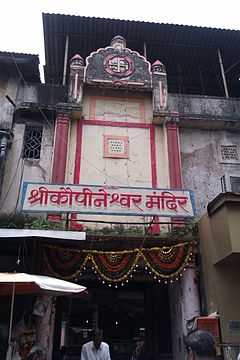Kopineshwar Mandir, Thane
| Kopineshwar Mandir, Thane | |
|---|---|
|
The main entrance of the Kopineshwar temple | |
 Kopineshwar Mandir, Thane Location within Mumbai region | |
| Geography | |
| Coordinates | 19°11′35″N 72°58′37″E / 19.193°N 72.977°ECoordinates: 19°11′35″N 72°58′37″E / 19.193°N 72.977°E |
| Country | India |
| State | Maharashtra |
| District | Thane |
| Culture | |
| Primary deity | Shiva |
Kopineshwar Mandir is among the most revered patron temples in Thane city & is a must visit for any devotee/ tourist coming to Thane.
Temple Complex
Located on the narrow but busy Bazaar Peth, Station Road, at the entrance gates, one is greeted by huge sized Nandi (Sacred Bull). The principal deity temple of Shiva has a 5 feet diameter by 5 feet tall Shiva Linga. Within the holy enclosure of the Kopineshwar temple are six small temple shrines dedicated to Brahma Dev, Rama, Maruti, Shitala Devi (Thatakai), Uttareshwar (Kashi Viswalingeswar) and Kalika Devi. Opposite to the shrine of Kalika Devi is another shrine dedicated to Gayatri Devi. Many of these shrine temples as still picturesque and still maintain the old red roof tile and wooden structure. The entire temple complex is quite & peaceful unlike the busy Thane station road surroundings.
As Thane is rightly known as the City of Lakes & as per Vaastu principles that the Canals, lakes, rivers are best if they are in north or east of the house/Temple - this ancient temple was also nestled on the banks of the Masunda Lake popularly known as Talao Pali. But a Municipal garden & road now running next to the Temple Complex reclaimed the land from the lake thus separating the lake.
Early history
The Silhara dynasty Kings who ruled Thane between 810 and 1240 AD were the devoted disciples of Lord Shiva & built the Kopineshwar Temple during their reign. It is popular belief that the temple has been built in the honour of Kopineshwar that was found under water.
Recent history
The temple reconstructed by the by Sarsubhedar Ramaji Mahadeo Bivalkar after Salsette was captured by the Marathas in approximately 1760. It was further repaired in 1879 by the Hindu community, at a cost of Rs. 8,000.
